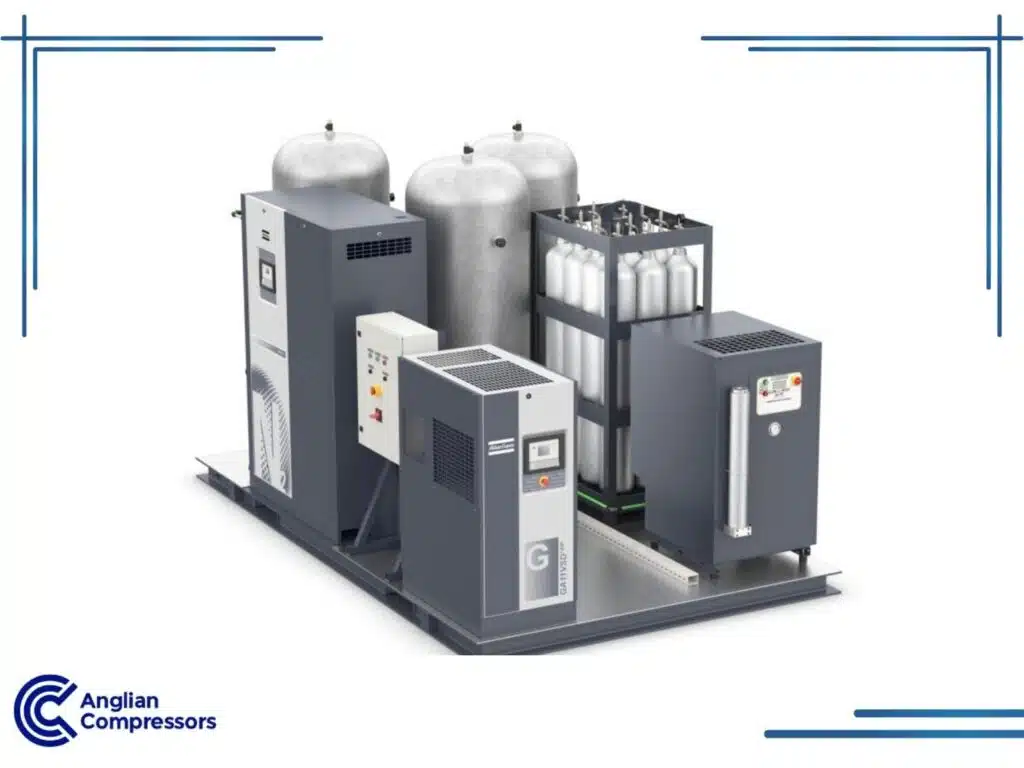What is a Compressed Air Booster?
Compressed air is extremely useful in industrial applications. However, it isn’t solely needed at a single bar/PSI pressure level. Instead, different air pressure levels are utilised, depending on the industrial application.
For example, PET bottle blowing and industrial cleaning applications require approximately 40-bar of air pressure. In comparison, air booster systems need to deliver upwards of 300-bar of high-pressure compressed air to perform laser cutting, or pressure testing.
What is a compressed air booster? It’s an additional unit, or system, added to an existing air compressor system to increase air pressure outputs. While an air compressor can typically deliver up to 15-bar of pressure starting with non-pressurised ambient air, going beyond this pressurisation level is not energy efficient.
Air boosters bridge this gap efficiently by increasing the pressure of already compressed air to meet high-pressure requirements.
Air boosters are designed to more cost-effectively increase, or boost, existing pressurised air to the necessary bar/PSI level. Therefore, whether 40 bar is required for stress testing purposes, or 300-bar is needed for gas handling or metallurgy, the air booster takes you the rest of the way.
The Need for Compressed Air Boosters
As the introduction indicated, what the compressed air is to be used for dictates the pressure level required. To make this simpler to understand, high-pressure applications are split into three category types: low, medium, and high.
Low, Medium, and High Air Pressure Levels
Low pressure is 15-bar and below. Most air compressor systems produce up to 15-bar with no additional equipment needed, so they fit into the low-pressure category.
Medium pressure is between 20-bar and 40-bar. Practical industrial applications at these enhanced pressure levels include power generation, PET blowing, industrial cleaning, and stress testing.
High pressure is 200-bar and above. Most needs for high-pressured air are in the 200 to 300-bar range, with some at 500-bar or even higher. For example, 300-bar pressure is required for metallurgy work, handling gas, and creating plastics. 300-bar is also useful when storing highly pressurised gas in high-pressure air cylinders for future use.
For example, laser cutting often requires air pressure in the 300-bar range to ensure precision and efficiency.
The Role of a Booster in Achieving Higher Pressure
Existing air compressor systems compress ambient air up to 15-bar. However, such systems are not cost-effective at higher pressure levels.
Air boosters are designed to cost-effectively amplify the pressure of pre-compressed air to meet high-pressure requirements. Depending on the booster, this may be on a 2:1 or 5:1 ratio, or another basis. The inlet receives the already-pressurised air and then increases its pressure by compressing it. Then the outlet releases the air to the machinery requiring it, or into high-pressure storage cylinders.
Increasing the pressurisation level on already compressed air is a better approach instead of taking ambient air and compressing it to a higher pressure level. Therefore, a multi-step process via both an air compressor and an air booster is warranted, to achieve enough pressurisation for medium or high-air-pressure tasks.
This stepwise approach avoids the inefficiencies of compressing ambient air to high pressure in a single stage.
How Does a Compressed Air Booster Work?
A compressed air pressure amplifier increases supplied air pressure beyond what a standard air compressor delivers. Instead of overloading a screw compressor, a booster amplifies the pressure of air, providing an energy-efficient solution for many industrial processes.
How It Works
- Inlet Phase – a standard air compressor supplies compressed air at 2 to 15 bar.
- Compression – the booster multiplies pressure to meet medium and high-pressure needs.
- Cooling and Filtration – removes heat, oil, and moisture for air purity.
- Discharge – delivers air to a storage tank or machinery at the required pressure.
Why Use a Booster?
- Boosters vs Compressors – using a pressure multiplier reduces energy costs and extends compressor lifespan.
- Oil-Free vs Oil-Lubricated – oil-free models ensure air purity for food and medical industries, while oil-lubricated options suit heavy industry.
By integrating a booster into a plant air system, businesses efficiently boost pressure without straining their compressors, ensuring reliable high-pressure air delivery.
Types of Compressed Air Boosters
Different companies have various air boosters, depending on which markets they serve.
At the time of writing, Atlas Copco offers three air boosters, which we briefly discuss below:
LB10-40 Air & Nitrogen Booster
- Purpose: Designed for medium-pressure applications like laser cutting and industrial cleaning.
- Specifications: Inlet pressure between 2-bar and 10-bar; output pressure up to 40-bar.
- Features: Single-stage, oil-lubricated, and air-cooled for continuous operation.
LB 300 Booster
- Purpose: high-pressure compressed air and nitrogen applications.
- Specifications: pressurises up to 300-bar, with an output of over 8 litres per second.
- Features: includes a built-in filtration system for water and oil removal, ensuring contaminant-free air.
LT Oil-lubricated High-Pressure Piston Compressor
- Purpose: suitable for medium-pressure tasks requiring up to 40-bar.
- Specifications:
- two-Stage Model: compresses air up to 30-bar.
- three-Stage Model: Reaches 40-bar for higher pressure needs.
- Features: highly durable and efficient for heavy-duty industrial applications.
Benefits of Using Compressed Air Boosters
Compressed air boosters provide a cost-effective, energy-efficient way to achieve high-pressure air. They ensure compressed air plays a critical role in industrial processes without overloading existing air compressor systems.
1. Reduced Energy Costs
Boosters deliver compressed air more efficiently by increasing pressure only when needed, reducing energy use compared to continuously running a high-pressure compressor.
2. Extended Compressor Lifespan
By allowing compressors to operate at lower pressures, boosters minimise wear, extending system life and reducing maintenance costs.
3. Flexible Pressure Control
Boosters provide adjustable pressure ranges to meet the demands of various air compressor uses, from oil and gas to laser cutting and nitrogen applications.
4. Safer and More Reliable
Boosters enhance system safety by preventing compressor overload. Built-in filtration ensures air purity, making them ideal for applications where air is critical.
5. Cost-Effective High-Pressure Supply
Instead of upgrading to an expensive high-pressure compressor, a booster is also a practical solution for increasing pressure efficiently within an existing plant air system.
With a compressed air booster, businesses can optimise energy, lifespan, and performance, ensuring consistent high-pressure air or nitrogen supply across various industrial applications.
The Practical Applications of Compressed Air Boosters
Air boosters are useful additions to air compressor setups to accommodate low-pressure systems. Rather than run an older air compressor at a higher pressure setting, a booster allows for lower initial pressure level outputs, and boosts compressed air from there. Even for newer compressors, this is more efficient.
Whether you need high or medium air pressure for different applications, such as within the shipbuilding, automotive, or mechanical engineering industries, air boosters are the most affordable way to create a steady supply of highly compressed air to the required level.
Boosters also enable the efficient storage of high-pressure air for applications requiring rapid deployment.

Conclusion
Most compressed air systems deliver a maximum of 15-bar of pressure, with the air compressors currently available offering between 2-bar and 15-bar. When requiring higher air pressure levels, adding an air booster is the best approach in many industrial settings.
Whether you need medium or high-pressure air, integrating an air booster with your existing compressor system ensures optimal performance across various industrial applications.
Get in touch with our team at Anglian Compressors to discuss your high-pressure air requirements.
FAQ
What is the role of high-pressure booster compressors in an industrial setup?
High-pressure booster compressors increase the air or gas pressure within an existing complete system. They take air already pressurised by a standard air compressor and boost it further to meet the specific pressure levels required for applications such as laser cutting or PET blowing. This approach helps deliver high pressure efficiently without overloading the primary compressor.
How does Atlas Copco UK’s range of compressor boosters benefit different industries?
Atlas Copco UK offers a range of versions with different outputs, making its compressor boosters suitable for a wide variety of industries. Whether you need a booster ideally suited for lower pressures or a high-pressure compressor for more demanding tasks, its solutions are maintenance friendly and quiet, providing an efficient and reliable way to meet high-pressure demands.
Why should I use a compressed air booster instead of upgrading my entire system?
A compressed air booster is a more compact, all-in-one solution than upgrading the entire system to deliver higher pressures. Boosters allow you to maintain your standard air setup while increasing the pressure only when needed, saving energy and costs. This method is particularly useful for systems that require high pressure but do not need to operate at those levels continuously.


